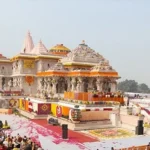Lord Shiva is considered to be the ultimate creator, destroyer and transformer of the universe. The temples devoted for Lord Shiva stands as a majestic symbol of spirituality and devotion. And thus they attract millions of devotees all through the year, to seek the blessings of the god. These famous Lord Shiva Temples promises a perfect blend of history, culture and divine connection. These temple sites are not just for seeking the blessings of the almighty. But they also serve as tourist spots and hiking adventures, that people can enjoy on the way to seeking blessings from Lord Shiva. Let us explore the most famous Lord Shiva Temples in India for the year 2024.
1. Khashi Vishwanath Temple, Varanasi:

The Kashi Vishwanath Temple is considered one of India’s most revered Hindu temples dedicated to Lord Shiva. The temple, located in the middle of Varanasi, serves as a spiritual center for millions of Hindus. Being one of Varanasi’s most prominent temples, the temple receives approximately 3,000 worshipers on a daily basis, with footfall increasing to 1,00,000 on important occasions. The importance of the Kashi Vishwanath Temple originates from its reference in various Hindu holy books.
2. Kedarnath Temple:

Kedarnath is the tallest of the twelve Jyotirlingas. This temple, which is almost a thousand years old, is constructed of massive stone slabs atop a big rectangular dais. The current temple is thought to have been rebuilt by Adi Shankaracharya after the Pandavas had previously built it. It is claimed that after the Kurukshetra war, the Pandavas came here to seek atonement from Lord Shiva, who was hiding in the form of a bull. The temple’s hallways now tell this story on their walls. Devotees think that visiting this temple will release them from the cycle of life and birth. The inside walls of this Shiva temple in India are sculpted with depictions of numerous deities and mythological themes.
3. Mahakaleshwar Temple:

This temple has the deity Lord Shiva as Mahakala. This temple is actually located inside a large courtyar and is been enclosed by huge walls. The temple has about five floors and one of the floors is kept underground.
4. Bhimashankar Temple:

Bhimashankar Temple is located in Khed, near Pune. This is also a Jyotirlinga shrine in India, and has the most well known Jyothirlingas in India. Apart from being a place of religious significance, it has also been designated as a Wildlife Sanctuary.
5. Amarnath Temple:

Amarnath Temple is a unique and holy temple located in the snow background in Jammu and Kashmir. This temple is infact located deep into the Amarantha Himalayan caves. Inside the cave, there is a naturally created ice lingam that represents Lord Shiva. Due to the severe weather conditions at such high altitude settings, this sacred site can only be visited during the brief pilgrimage season that occurs each year, which normally lasts from July to August. Pilgrims have to climb up the mountains to visit the Lord. But this hurdle and test is nothing before the faith and commitment they have towards the god.
6. Somnath Temple, Gujarat:

The architectural wonder is one of the best temples and the most visited temple of Lord Shiva. This temple, too, transforms into a sea of worshipers during Shivratri. The temple withstood the test of time, despite being assaulted and looted numerous times throughout the years. Somanath Temple, one of the twelve Jyothirlinga temples, has been restored in the Maru-Gurjara style near the seashore.
7. Rameshwaram Temple, Tamilnadu:

The Rameshwaram Temple, is a significant site of Hindu mythology and history and is pivotal for the beliefs of Hindus. Of the 12 Jyotirlingas that Lord Shiva has, this is the Southern most Jyothirlinga. This temple has deep connections with Ramayana. Pilgrims who visit this temple will take bath in the beach known as the Agni Theertham and pray to the lord.
8. Arunachaleswara Temple, Tamilnadu:

The Arunachaleswara Temple in Thiruvannamalai houses the Agni Linga, and this temple represents the fire element of the Lord. Arunachaleswara Temple, also known as the Jyothi Lingam, is one of the country’s most well-known Pancha Bhoota Sites. The temple complex, is one of the largest in the country and covers about ten hectres of land. According to history, Lord Shiva appeared as a massive column of flames on top of the hill. Every year on Karthiga pournami, devotees will light up flame on top of the hill and worship lord in the form of Agni.
9. Lingaraja Temple, Bhubaneswar:

The Lingaraja Temple in Bhubaneswar, Odisha, is an outstanding example of Kalinga architecture, with elaborate carvings and high spires. The temple complex is one of India’s oldest Shiva shrines, honoring Shiva as Tribhuvaneshwara, or “Lord of the Three Worlds.” Construction most likely began in the sixth or seventh century CE, with additional structures added over the centuries to form a massive masterpiece. The revered self-manifested (Swayambhu) Shiva linga is housed within and attracts thousands of devotees every day.
10. Mallikarjuna Temple, Srisailam:

The Mallikarjuna Temple in Srisailam, Andhra Pradesh, is one of Lord Shiva’s twelve avatars and has a deep spiritual importance. It is also known as a Shakti Peetha since it is where parts of Goddess Sati’s body fell following her self-immolation. The temple, is located on the banks of the Krishna river. It attracts the pilgrims to seek the blessings of the lord and to attain spiritual enlightenment. This is one of the places that witnessed the sacred union of Lord Shiva and Parvati.
These top Shiva temples in India, are a divine grace for Hindus. These temples are spread from the snow mountains of the Himalayas till the shores in the southern part of India. The sun rises and sets its golden hues on the ancient stones of these temples, inorder to pay homage to lord Shiva. With the help of the sacred chants, fervent prayers and the ritualistic offerings, these temples attempt to transcend and connect with the divine essence, that permeates this universe.


